SD › Best Places to Stay in L.A.
Updated: January 2, 2024
By Santorini Dave
Our Favorite L.A. Hotels
• 5-star: The Maybourne
• 4-star: JW Marriott (Downtown)
• 3-star: Freehand L.A.
• For couples: Kimpton La Peer
• For families: Fairmont Miramar
• Beach: Shutters • Casa del Mar
• Hotel pool: Beverly Hills
• Near LAX: Hyatt Regency
• Disneyland: JW Marriott
• Universal Studios: Hilton
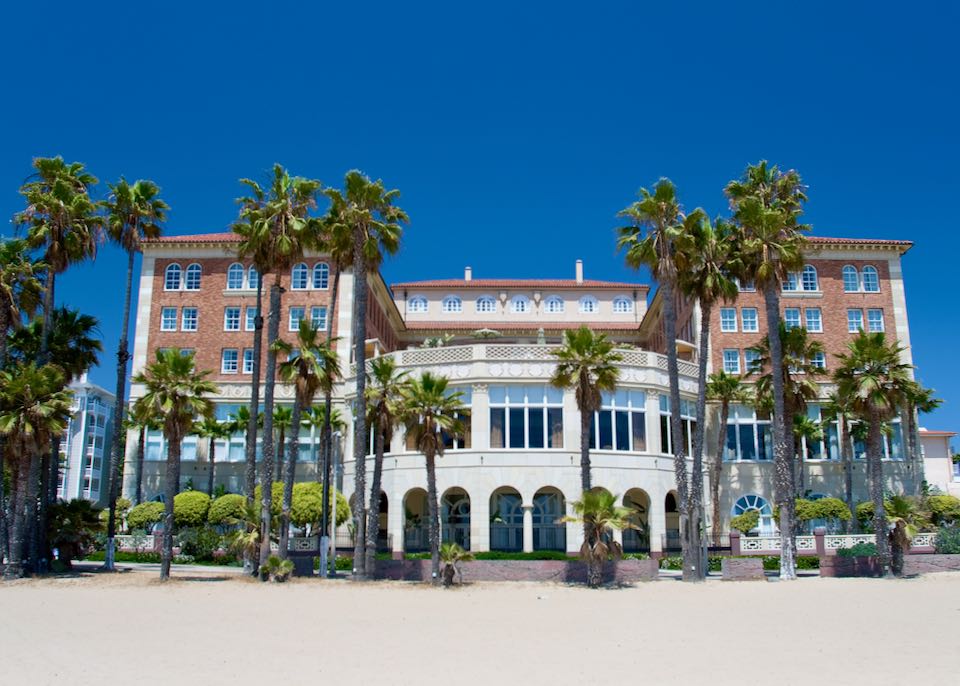
The awesome Hotel Casa del Mar on Santa Monica Beach in Los Angeles. A great location for first-time visitors to LA.
Best Areas to Stay in Los Angeles
Los Angeles is an immense city of unique, well-defined neighborhoods that can feel like large cities themselves. And since the best things to do in LA are spread throughout the city and its suburbs, there isn’t one best part of town to stay in. LA has neighborhoods for almost any interest, whether beaches, high-end shopping, celebrity sightings, art galleries, nightlife, or food. Accordingly, the best hotels in Los Angeles are not focused in one specific neighborhood. It’s easy to find great accommodations ranging from budget to luxury in most areas of Los Angeles.
My wife and I on Venice Beach.
Downtown Los Angeles is the historic and financial heart of the city, packed with artistic and cultural attractions, including the famous Grand Central Market food court, Walt Disney Concert Hall, and the majority of the theaters. It’s also the central hub of the city’s public transport (including the Metro), making day-trips relatively straightforward.
Hollywood is a major tourist hub in its own right; this is where you’ll find Grauman’s Chinese Theatre, the Hollywood sign, Hollywood Boulevard, and many of the nightclubs. If traveling by car, Hollywood makes for a more central location for which to explore the region.
South of Hollywood you’ll find additional neighborhoods that include Larchmont Village, Wilshire District, and the Fairfax District. In these areas, you’ll find the Original Farmers Market, The Grove shopping center, and many streets packed with shops and restaurants, including Beverly Blvd, Fairfax Blvd, 3rd Street, and Melrose Blvd.
West of Downtown and Hollywood you’ll find the upscale residential areas of West Hollywood, Beverly Hills, and the beaches in Venice, Santa Monica, and Malibu. West Hollywood is a safe, relatively central option for seeing the whole city, best known for nightlife and shopping with an abundance of bars and music venues. The Sunset Strip, also known for its nightlife, forms its northwest boundary. Beverly Hills is the home of – unsurprisingly – pricey hotels and a handful of attractions, like the famous Beverly Hills Hotel and high-end shopping on Rodeo Drive, while artsy neighborhoods such as Echo Park and Silver Lake are places to soak up the vibe rather than see sights. Santa Monica and Venice are LA’s most celebrated beach enclaves, perfect for experiencing California beach culture but a long way from the cultural attractions inland. Affluent Malibu, further west along the coast, is best seen as a standalone destination, an easy day-trip but too far from the action to be considered a base for exploring the rest of LA.
At the city’s south end, Long Beach and San Pedro are real surprises, crammed with family-friendly attractions, though similarly quite long commutes from the rest of LA.
Beyond the city proper, Los Angeles County is a sprawling metro area and includes many communities, villages, and neighborhoods. There are some places on the east side of LA that are also worth exploring like Silverlake, a quirky neighborhood known as more of an artist’s enclave with more obscure nightclubs and bars, and Los Feliz, where you’ll find the LA Zoo, Griffith Observatory, and Griffith Park. West of the Cahuenga Pass and over the hill from Hollywood you’ll find Studio City and the beginning of the San Fernando Valley or simply “the Valley,” home to the famous movie studios of Burbank and Universal City, while the San Gabriel Valley is anchored by historic Pasadena, a fun city to explore in its own right. To the south, Orange County features the ever-popular Disneyland in Anaheim.
Traditionally, the most popular way to get around LA is to drive. However, traffic is stop-and-go much of the day and improved public transport means that driving is no longer the fastest way to get across the city. We still recommend a car to see sights in Greater LA (the Valley, Malibu, Orange County) – it’s easy and relatively cheap to rent one in LA (taxi and Uber fares can build up fast thanks to LA’s long distances). LA’s Metro is a great and safe way to see the city, with the main hub at Union Station in Downtown LA: the Gold Line runs to Pasadena, the Red Line covers Hollywood, the Purple Line connects to Koreatown (for Miracle Mile), and the Expo Line reaches Exposition Park/USC, West LA and Santa Monica. Fares are a flat $1.75 or $7 for a one-day pass. DASH buses offer useful routes throughout Downtown LA – they are currently free.
The weather in Los Angeles is dry and sunny for the majority of the year. Average highs are in the mid-30s°C (mid-90s°F) in the summer and low 20s°C (low-70s°F) in the winter, making it a great vacation destination any time of the year. Mid-September through mid-October is one of the best times to find spectacular weather and great prices on hotels as the summer crowds have left. Spring is the rainiest season in Los Angeles and the most unpredictable for weather, although it will rarely rain for more than a few hours on any given day.
One thing to note in Los Angeles: Book hotels early. There are many sporting events, conventions, and conferences throughout the year, including star-studded galas like the Grammys and Academy Awards. Booking a hotel during events like these and throughout summer should be done about 3 to 4 months in advance. For slower seasons, try to reserve rooms at least a month in advance.
Best Places to Stay in Los Angeles
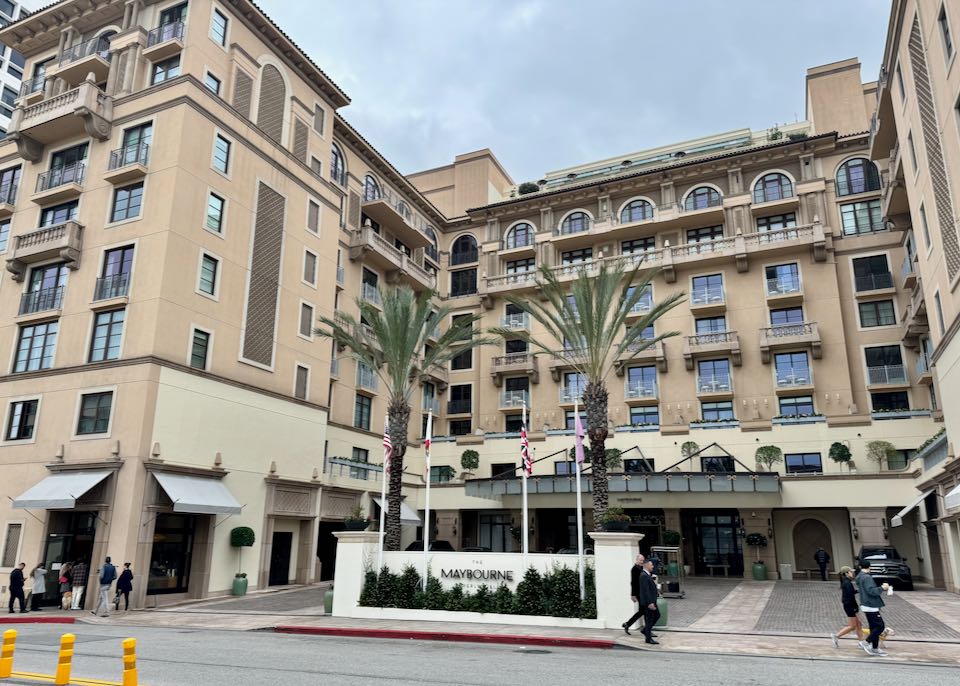
The Maybourne is the best luxury hotel in Beverly Hills. A two-minute walk from Rodeo Drive and the Golden Triangle. The California and Hollywood suites are particularly wonderful.
- Best Luxury Hotels in Los Angeles
The Maybourne • Beverly Wilshire • Shutters on the Beach • Hotel Bel-Air • Beverly Hills Hotel • Ritz-Carlton Downtown- Best Beach Hotels in Los Angeles
Shutters on the Beach • Hotel Casa del Mar • Hotel Erwin • Surfrider Hotel Malibu • Oceana Santa Monica- Best Boutique Hotels in Los Angeles
Kimpton La Peer Hotel • Malibu Beach Inn • Plaza La Reina • Surfrider Hotel • Nobu Ryokan Malibu- Best Hotels for Families in Los Angeles
JW Marriott Downtown • Four Seasons at Beverly Hills • Fairmont Miramar • Langham Huntingon Pasadena • Andaz West Hollywood • Holiday Inn Express Hollywood- Best Cheap/Midrange Hotels in Los Angeles
SIXTY Beverly Hills • Freehand (Downtown) • Holiday Inn Express Hollywood- Best Hostels in Los Angeles
HI Los Angeles Santa Monica Hostel • Samesun Hollywood • Samesun Venice Beach
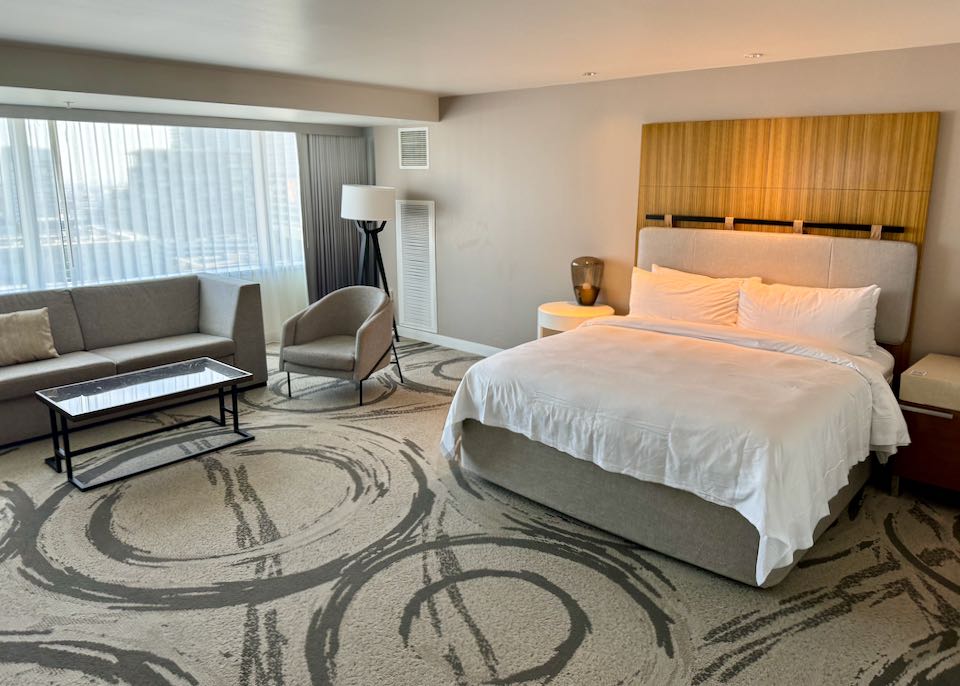
Our suite at the JW Marriott in downtown Los Angeles.
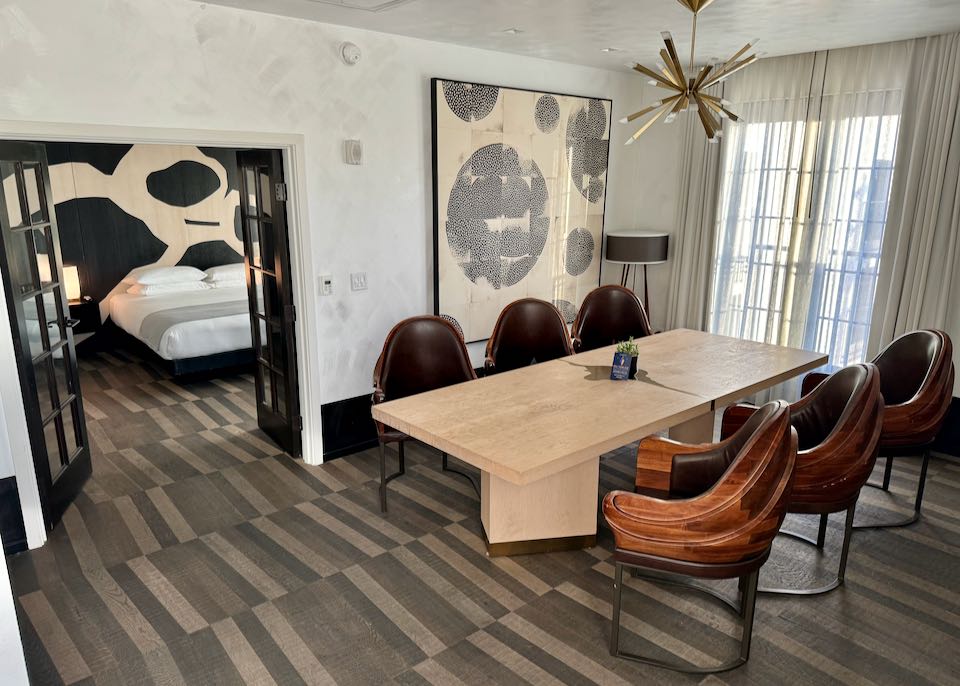
Our suite at the Kimpton La Peer Hotel in a quietly trendy neighborhood of West Hollywood. There’s a nice walking path nearby that goes all the way to Beverly Hills.
Best Neighborhoods in Los Angeles for…
- Best Neighborhoods in Los Angeles to Stay for First Timers: Hollywood and Santa Monica
The most important thing to consider for first-time visits is that the city is very big and traffic is heavy. Choosing a hotel based on your main sightseeing goals is wise here. First-time visitors to LA have a lot of options but we recommend Hollywood or Santa Monica. If you want a lot of beach time, Santa Monica is a great choice. There is a great walking and biking path that connects to Venice Beach, spectacular sunsets every night, a walkable downtown, excellent shopping, a dynamic culinary scene, and a Metro connection to Downtown LA and the rest of the city. Santa Monica Pier sits on a wide stretch of beach and offers an amusement park, small aquarium, and an arcade. It is also the end of Route 66, and you can see the iconic sign at the entrance to the pier. Just inland from the beach is Santa Monica Place, an open-air shopping center filled with restaurants and great boutique shops. The main downside is travel time: by car or by Metro, staying in Santa Monica means a lot of effort to explore the rest of LA.Hollywood is another great spot to make your home base. Its central location means easier access to the city’s attractions (the Metro runs here also). Of course, there is Grauman’s Chinese Theatre, the Hollywood sign, and Hollywood Boulevard here, packed with famous restaurants, the Walk of Fame, and family-friendly museums. It’s also close to Universal Studios, Griffith Park and Observatory, Los Angeles Zoo, Paramount Studios, the Hollywood Bowl, and the Hollywood Forever Cemetery, home of “movie under the stars” by Cinespia. The downside: Hollywood is easily the most touristy place in LA, and can still be a little rough around the edges at night beyond the main drag.
- Best Neighborhoods in Los Angeles for Nightlife: Hollywood and West Hollywood
There are a huge range of clubs and bars throughout all of Los Angeles but Hollywood and West Hollywood are the top nightlife hotspots with a wide array of bars and music venues. Hollywood boasts some of LA’s most iconic watering holes, including Musso & Frank Grill, Boardner’s, Burgundy Room, Formosa Café and the Frolic Room (at 6245 Hollywood Blvd, the oldest dive bar in LA since 1930). Higher end options include the fashionable bars and poolside bars in hotels such as W Hollywood and Hollywood Roosevelt. There’s also live comedy at the Upright Citizens Brigade Theatre and Second City, and live bands at Amoeba Music and Hotel Café. Hollywood is also LA’s club hotspot with Avalon Hollywood and Sound as dependable options. Throughout the year you’ll find live music at several clubs, thought most don’t get started until after 9:00 pm.Just a short cab ride away is West Hollywood, where the Sunset Strip is home to legendary live music clubs like The Roxy, Whisky a Go-Go and Johnny Depp’s Viper Room (opened by Johnny Depp), with Troubador not far away, comedy clubs such as the Comedy Store, and the LGBT-friendly strip along Santa Monica Boulevard.
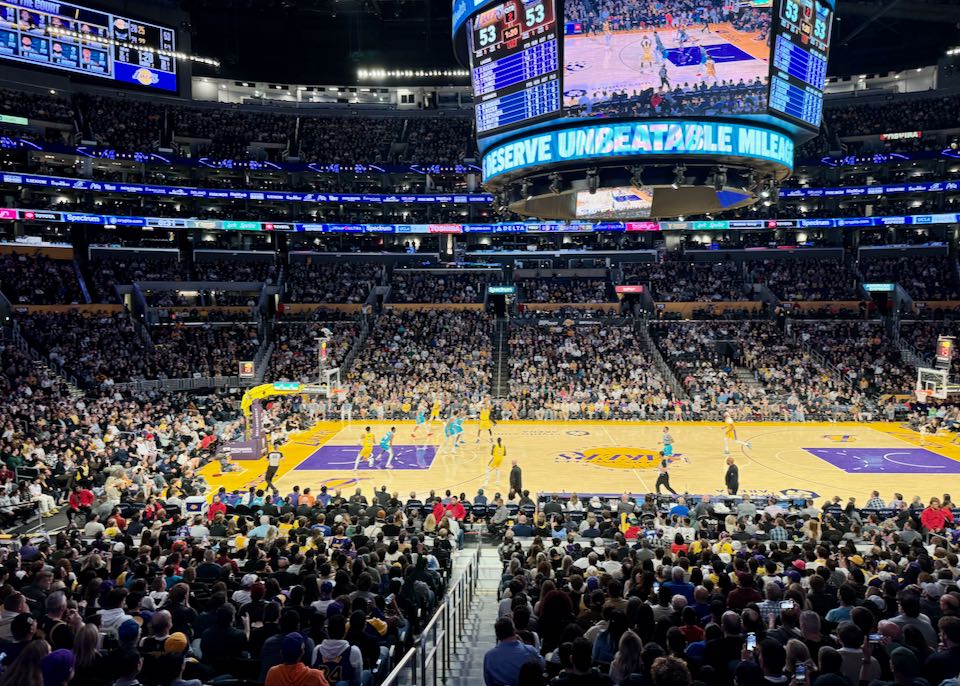
Watching a Lakers game at Crypto Arena is a must for basketball fans.
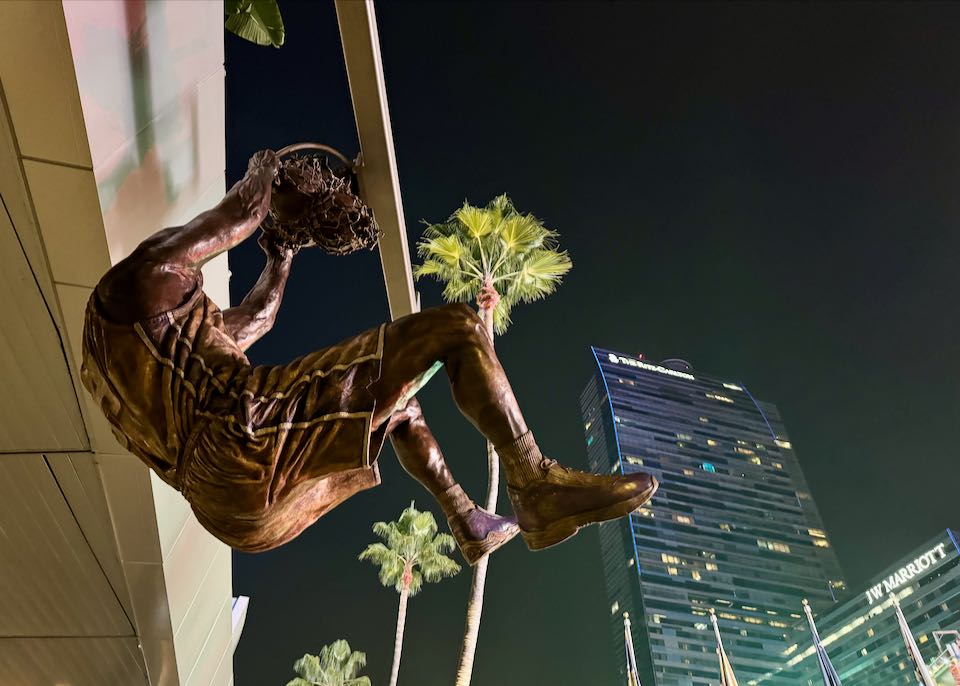
A statue of Shaq outside Crypto.com Arena. The Ritz-Carlton and JW Marriott are the two best hotels close to the arena. Both are a two-minute walk from Lakers, Clippers, Kings, and Sparks home games.
- Best Neighborhoods in Los Angeles for Food and Restaurants: Beverly Hills, Santa Monica, Downtown, and Silver Lake
Head to Beverly Hills and Santa Monica for a wide range of upscale dining. A few not-to-miss restaurants are Nate ‘n Al’s, Maude, and Spago in Beverly Hills. For brunch, head to The Polo Lounge at the Beverly Hills Hotel.For the hottest new restaurants in the city, Santa Monica is hard to beat; spread out across the neighborhood there’s high-rated Pasjoli, Birdie G’s, Colapasta, Melisse, and Socalo. These in addition to old classics such as Father’s Office, and Red O from Rick Bayless. Also in Santa Monica, check out Forma. Fia is your top choice for brunch near the beach.
For sheer diversity, Downtown LA is a solid bet: in addition to the high-end restaurants in the Financial District and Arts District (like Bavel, Bestia, and Redbird), there are the Japanese spots in Little Tokyo (Daikokuya), Mexican specialists in El Pueblo (Cielito Lindo), and food halls bites in Grand Central Market. There’s also historic American classics such as Cole’s French Dip, Original Pantry Café, and Philippe the Original, plus sushi fan favorite Sugarfish.
For a more local, fresher, and slightly cheaper scene, Silver Lake is the place to go. All within a relative short distance are All Day Baby, Dayglow, Filipino favorite Spoon & Pork, and Taiwanese small plates at Pine & Crane. Silver Lake is best visited from elsewhere, as there are not many places to stay, though Silver Lake Pool & Inn is an excellent boutique option.
That said, Los Angeles is a foodie town, and the best restaurants are scattered throughout the city. Los Angeles has the only official Thai Town in the US, located in East Hollywood. Nearby are the bakeries and kebabs of Little Armenia, between Los Feliz and Silver Lake. The Fairfax area is where you’ll find one of the best delis in the city, Canters, as well as the Original Farmers Market dating back to 1934 and offering over 100 gourmet grocery and food kiosks.
- Best Neighborhood in Los Angeles for Families: Santa Monica
This beach town has some great resort hotels and, of course, the uber-fun Santa Monica Pier. The pier has been the backdrop for many movies and TV shows and has restaurants, street artists, and the Pacific Park amusement park which is packed with rides, games, food, and all kinds of family fun. At the end of the Santa Monica Pier is a sign that marks the end of the legendary American Route 66 highway. Beyond the pier is a wide stretch of beautiful sandy beach and a great walking and biking path.- Most Romantic Neighborhoods in Los Angeles: Malibu and Santa Monica
Some of the most beautiful and luxurious hotels in the world can be found throughout Los Angeles and can set the stage for a truly romantic vacation. Los Angeles offers a variety of romantic things to do throughout the city, including a concert at the Hollywood Bowl, a visit to the Griffith Observatory at night to stargaze, taking in a sunset from the cliffs in Malibu, and brunch at the Polo Club. For a honeymoon or romantic getaway, it’s hard to beat Malibu with its exclusive beachfront hotels, laidback vibes, and high-end restaurants like Nobu. It’s not all super-expensive though – enjoy sunset drinks at ocean-facing Paradise Cove Beach Café or a view of the “Queen’s Necklace” at surf and Hawaiian-themed Duke’s Malibu. Inland there are numerous parks and trails to wander – Malibu Creek State Park contains the remains of the M*A*S*H TV show set – and a growing number of small wineries to sample, among them Cornell Winery & Tasting Room and Malibu Rocky Oaks. Among the most romantic hotels is the oceanfront paradise of Malibu Beach Inn, which sits on a section of the coast named Billionaire’s Beach. Santa Monica is another strong choice for a romantic getaway. Check out Shutters on the Beach or Hotel Casa del Mar, both ideal for strolling on the beach at sunset and enjoying candlelit, waterfront dinners.
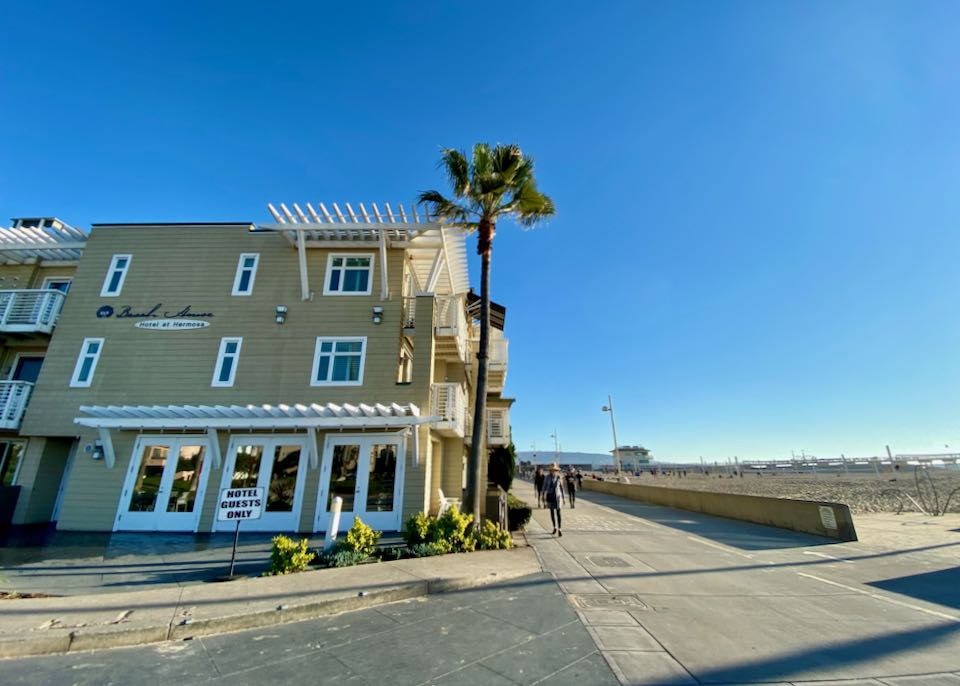
The Beach House on Hermosa Beach, one of our favorite beachfront hotels in the Los Angeles region and just a 20-minute drive from LAX.
- Best Neighborhoods in Los Angeles for a Local Vibe: Los Feliz, Silver Lake, Larchmont Village, Echo Park, and Hermosa Beach
These neighborhoods offer a great opportunity to meet locals and get a much different viewpoint of Los Angeles. Larchmont is a neighborhood just below Melrose Blvd and near Hancock Park that has a quaint old-town shopping street and beautiful historic homes. Los Feliz is a neighborhood with plenty of old-school watering holes, hip shops, and cafés. It is also home to two Frank Lloyd Wright homes. The neighborhood borders Griffith Park where you’ll find several great hiking trails, the Greek Theatre, and the Griffith Observatory. Just east of Los Feliz is the neighborhood of Silver Lake. It’s an artsy area drawing a hipster crowd, with its several funky shops, street art, artisanal coffee shops, creative eateries, and indie music venues.Around three miles northwest of Downtown LA is Echo Park. Set around Echo Park Lake (where you can rent swan paddleboats) and a short stretch of Sunset Boulevard, it’s an easy-going neighborhood of artists, musicians, and hipsters, with cool restaurants and coffee shops that tend to be (relatively) cheap for LA. There’s not a lot to see, but Mohawk Bend deserves at visit. There’s not much choice in terms of accommodation: Noon on Sunset Hill is the best of a very small list, with Downtown LA otherwise the closest place to stay.
For a beach vibe we recommend Hermosa Beach, which still retains a bohemian 1960s’ and laid-back surfer feel despite being a relatively affluent community today. Other than strolling the pleasant boardwalk, Hermosa Beach Pier, and the beach itself, there’s not much in the way of sights, but nightlife is surprisingly good. Lighthouse Café opened as a jazz club in 1949, and there’s a large array of surfer bars and dives – try Hennessey’s Tavern. Again, there’s not much choice when it comes to hotels here, but the best are Beach House and H2O Hermosa.
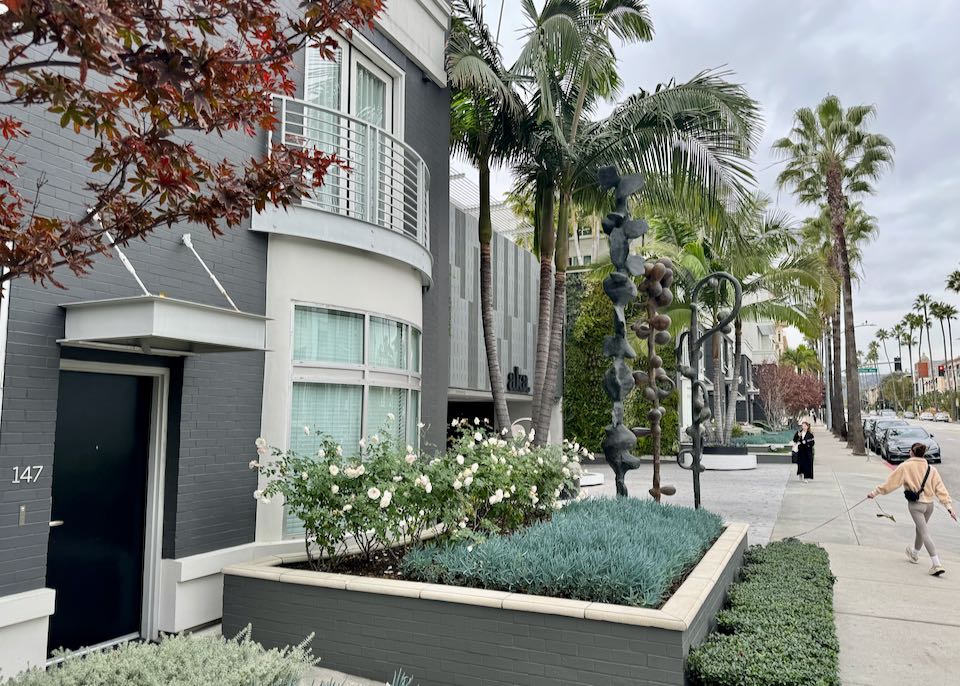
The one-bedroom and two-bedroom townhomes at AKA Beverly Hills have their own entrance and a full kitchen. They do need to be rented for at least a week.
- Best Neighborhood in Los Angeles without a Car: Downtown LA, Hollywood, West Hollywood, Venice Beach, and Santa Monica
You might have heard that nobody walks in LA but this isn’t entirely true. Head to Venice or Santa Monica and you can jump on the 22-mile paved bicycle and walking path that runs along the Pacific coastline, from Will Rogers State Beach (north of Santa Monica) in the Pacific Palisades to Torrance County Beach (in the south). West Hollywood (along with Santa Monica) is one of the most walkable cities in Southern California. West Hollywood is only 1.9 square miles, so all of the city’s best attractions are in close proximity. Hollywood and its top sites are also best explored on foot.Downtown LA is one of the city’s most walkable neighborhoods – and with free Dash buses zipping between the main sights. In addition to world-class museums like The Broad and Museum of Contemporary Art (MOCA), there’s a burgeoning nightlife and culinary scene, especially in Grand Central Market and amongst the galleries of the Arts District. Little Tokyo and El Pueblo are fascinating enclaves of Japanese and Mexican/Spanish culture respectively, while Chinatown lies just to the north. The Jewelry and Fashion districts offer intriguing shopping opportunities while the Grammy Museum anchors the LA Live entertainment complex and the Crypto.com Arena is home to the Lakers.
- Best Neighborhood for Shopping: West Hollywood and Venice Beach
Several neighborhoods offer great shopping in LA: Downtown (especially the Arts District, Jewelry and Fashion Districts), Rodeo Drive (for luxury), Santa Monica, Koreatown, Hollywood and giant malls such as the Westfield Century City, but our favorites are West Hollywood and Venice. Within fairly close proximity in and around West Hollywood there’s the massive Beverly Center mall, with over 100 stores, The Grove outdoor mall and entertainment district (with its celebrated Farmers’ Market), and Melrose Avenue, a blend of high-end boutiques and more grungy, indie stores.In Venice, the boardwalk features everything from beach and surf shops to hippie jewelry and incense, while inland, Albert Kinney Boulevard is one of the hottest shopping strips in LA. Some of the coolest indie designers are here, from SALT and Marine Layer to the bags at Timbuk2.
- Safest Areas of Los Angeles
Los Angeles’ safest neighborhoods tend to be the most affluent ones of Bel Air, Beverly Hills, Malibu, Pacific Palisades, Hermosa Beach and West Hollywood. Most touristy areas are safe, especially during the day, but standard precautions apply at night. It’s also worth noting that there are sections in Hollywood and the beach cities, especially Venice Beach, that can bring some interesting characters.- Unsafe Areas of Los Angeles
Regarding safety, LA has extremes with uber-rich and safe areas as well as some seedy and unsafe areas. While most of the touristy neighborhoods such as Hollywood, Beverly Hills, or Santa Monica are safe, LA has some dangerous areas downtown (Skid Row) and nearby (South Central). Like many other cities in California, homelessness is prevalent in LA, with Downtown, Hollywood, Venice, and even Santa Monica hosting large populations of street sleepers. As with any big city, be careful, especially at night, and don’t wander alone.The 13 Best Neighborhoods in Los Angeles for Tourists
The Loews Hollywood is fantastic if you want to be near the center of the action, steps from the Walk of Fame.
1. Hollywood
Hollywood is a great place to stay for first-time visitors to Los Angeles – and especially good if you don’t plan on renting a car. This conveniently central neighborhood is a public transportation hub, connected to the Metro system and overall, a great area for exploring the rest of LA by car or public transport. Hollywood has been associated with the movie industry since the 1920s, and though few movies are made here anymore, the short blocks of Hollywood Boulevard in downtown Hollywood are crammed with film-related attractions – as well as some of the most iconic bars and restaurants in LA. The boulevard features the embedded pink terrazzo and brass stars of the Hollywood Walk of Fame, in addition to family-friendly favorites such as the Hollywood Wax Museum, Guinness World Record Museum, and Madame Tussauds Hollywood. The Hollywood Museum gives better sense of the neighborhood’s history, while the Dolby Theatre, part of the Hollywood & Highland Center, is where the current annual Academy Awards take place. Of the strip’s historic 1920s theaters, the best known is the Chinese Theatre, its forecourt lined with celebrity handprints and footprints in cement, though the Egyptian Theatre is equally ornate. Paramount Studios (which runs tours) and the Hollywood Forever Cemetery lie just to the south, while Hollywood Heights is to the north, and Griffith Park and the iconic Griffith Observatory loom high in the hills to the northeast – with the best views of the famous Hollywood sign.
- Best Hotels: Loews Hollywood • Thompson • Kimpton Everly Hotel • Dream Hollywood • Hollywood Roosevelt
- Best Midrange Hotel: Hampton Inn & Suites • Elaine’s Hollywood Bed and Breakfast • Holiday Inn Express Hollywood
- Best Hostel: Samesun Hollywood
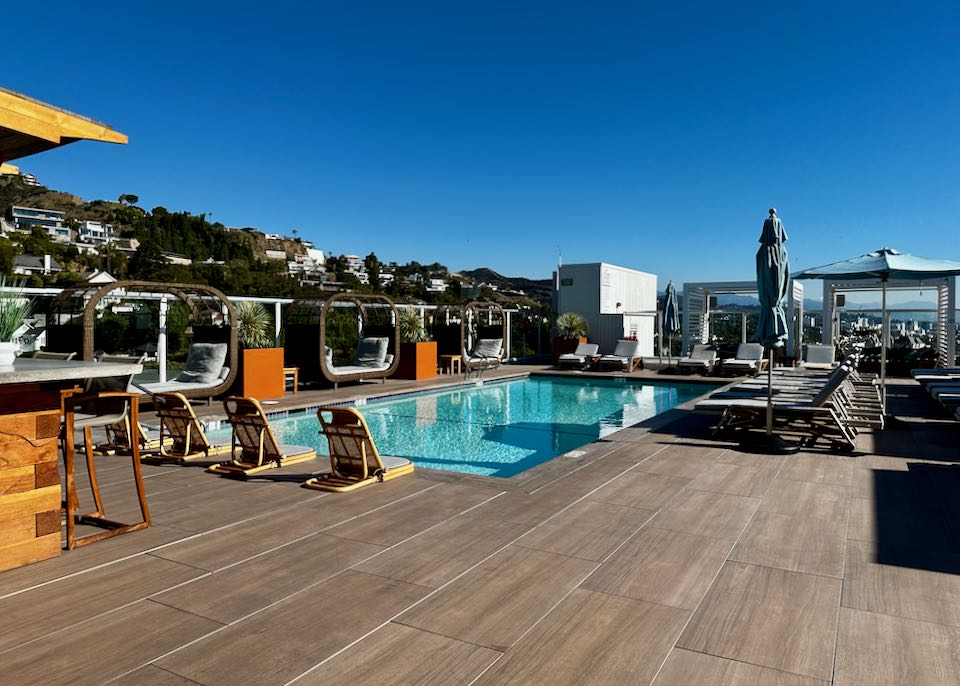
The trendy and friendly Andaz Hotel in West Hollywood.
2. West Hollywood
West Hollywood, anchored by Santa Monica Boulevard between Beverly Hills and Hollywood proper, can be a fun place to stay despite containing few conventional sights. One of the most walkable cities in Southern California, the 1.9 square miles includes restaurants and shops and is one of the top neighborhoods for nightlife in LA. Santa Monica Boulevard is home to a number of gay bars, dance clubs, and shops. The ONE National Gay & Lesbian Archives is the largest active LGBTQ organization in the US, housing the biggest collection of books, photographs, artworks, and personal papers of its kind in the world. Sunset Strip still boasts celebrated clubs and bars like Whisky a Go Go and the Viper Room. The West Hollywood Design District features galleries, furniture designers and fashion boutiques, and merges to the east with the most celebrated blocks of Melrose Avenue, still LA’s trendiest shopping street. The main Melrose strip runs for almost two miles from North La Brea Avenue to La Cienega Boulevard (storied Melrose Place branches off Melrose Avenue just beyond Orlando Avenue). Two blocks north of Melrose, the MAK Center for Art and Architecture is one of the neighborhood’s few museums. Though the area has yet to be connected to the Metro system, local buses do crisscross West Hollywood, and it’s a conveniently central location in which to be based if driving.
- Best Hotels: Andaz West Hollywood • Sunset Marquis Hotel • Kimpton La Peer Hotel • Petit Ermitage • Hotel 850 SVB • The Charlie
- Best Cheap/Midrange Hotel: Best Western Plus Sunset Plaza Hotel
- Best Hostel: Banana Bungalow – West Hollywood Hostel
3. Beverly Hills
Known for its opulence, the upscale shopping street of Rodeo Drive, and its famous 90210 zip code, Beverly Hills is synonymous with luxury, fame, and wealth. The “Golden Triangle” district south of Santa Monica Boulevard is where most of the action takes place – north of here it’s mostly residential. Other than gawking at some of the landmark stores, or grabbing a pricey meal or cocktail in iconic hotels such as the Beverly Wilshire and Beverly Hills Hotel, there’s only a handful of attractions. The Rodeo Drive Walk of Style is a fashion version of Hollywood’s Walk of Fame, while the Paley Center for Media is the neighborhood’s only museum. Beverly Gardens Park contains the iconic Electric Fountain and Beverly Hills Sign. In the residential zone, one of the few estates open to the public is the shady Virginia Robinson Gardens. Not to miss restaurants include Spago, Maude, and Tempura Endo. The Beverly Hills Trolley offers tourists a free 40-minute ride around the main highlights; it usually departs hourly from the corner of Rodeo Drive and Dayton Way. Beverly Hills is relatively central for exploring the city, but there’s no Metro so a car is a better option.
- Best Hotels: Peninsula Beverly Hills • Beverly Hills Hotel • Beverly Wilshire • L’Ermitage • Waldorf Astoria • Four Seasons Hotel at Beverly Hills • The Maybourne
- Best Midrange Hotels: SIXTY • Sonder Beverly Terrace
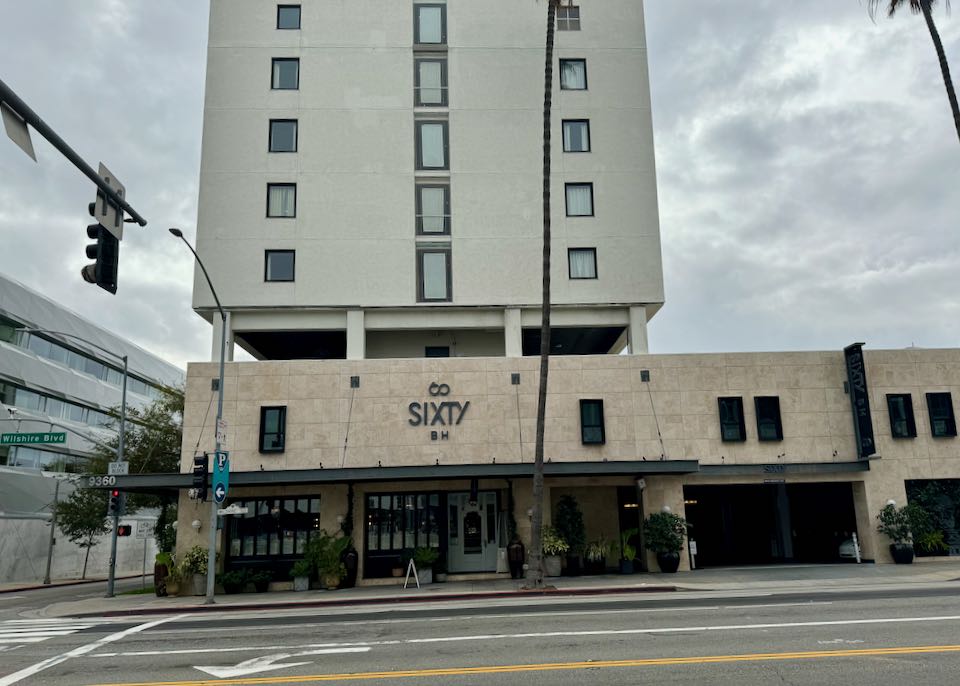
The SIXTY is a great midrange hotel on Wilshire Boulevard, just a five-minute walk from the trendy shops and restaurants on Rodeo Drive.
4. Downtown
The historic heart of LA, Downtown is now the region’s financial and commercial center, a forest of gleaming skyscrapers surrounded by a some of the city’s best museums, buzz-worthy restaurants, and hip bars. Thanks to projects such as the Crypto.com Arena (home to LA sports teams the Kings, Lakers, Clippers and Sparks), LA Live mall, and a spate of construction, Downtown has boomed in recent years (though the notorious Skid Row on the east side remains here). El Pueblo de Los Angeles, the city’s reconstructed Spanish/Mexican historic core, is crammed with sights, while LA’s vibrant Chinatown lies just to the north. In the historic Broadway Theatre District, there are 12 movie theaters that were built between 1910 and 1931. Other attractions include the Museum of Contemporary Art, The Broad art museum, Frank Gehry’s Walt Disney Concert Hall, Grammy Museum, and LA’s iconic Art Deco City Hall. Other areas to explore include Little Tokyo, the burgeoning Arts District, and the Fashion District. Downtown’s culinary scene is equally varied, from ramen shops to chic contemporary restaurants like Bestia and Grand Central Market a popular food hall. Some of the oldest and most popular restaurants in the city are located downtown, including Philippe the Original and The Original Pantry Cafe. Staying here means being at the central hub for the Metro and city transportation.
- Best Hotels: Ritz-Carlton Downtown • Hotel Per La • JW Marriott • InterContinental Downtown • Level Downtown South Olive
- Best Cheap/Midrange Hotels: Hotel Indigo • Freehand • The Hoxton • Ace Hotel
5. Venice Beach
Staying here is all about the beach – there are also a few sights, good eating, and plenty of shopping on offer, but the wide strip of sand and famous boardwalk are the primary draws. The 2.5-mile Venice Beach Boardwalk is best experienced by walking and enjoying the oddball people and shops complete with tattoo parlors, cannabis shops, street vendors, and lots of street performers. Skate Dance Plaza and the open-air gym Muscle Beach, filled with bodybuilders and beachgoers, are two of the most famous spots here. The main strip ends at 1,300-foot long Venice Pier and locally celebrated Hinano Café. Running inland, Windward Avenue is Venice’s main drag, home to the Venice Sign. Windward runs into Abbot Kinney Boulevard, a mile-long stretch of shops that includes great second-hand stores, restaurants, coffee shops, antique stores, and galleries. The 3-star and 4-star hotels can be expensive in Venice Beach and you’ll need to head to nearby Marina Del Rey for a 5-Star hotel experience. It’s an easy two-mile walk between Santa Monica Pier and Venice Beach, but numerous buses also link the two on Main Street (bus #1). Parts of Venice can be unsafe at night, and walking on the beach after dark is illegal in many stretches.
- Best Hotels: Ritz-Carlton Marina del Rey • Hotel Erwin
- Best Cheap/Midrange Hotels: Inn at Venice Beach • Su Casa at Venice Beach
- Best Hostel: Samesun Venice Beach
6. Santa Monica
In this beach city, you’ll find excellent shopping, dining, and many family-friendly attractions like the amusement park on the pier, a celebrated beach, and the cliffs of Palisades Park anchoring the seafront. Next to the pier is Santa Monica’s version of Muscle Beach, an outdoor gym established in the 1930s. Biking, skating, and surfing are all top things to try when visiting. Santa Monica is a fairly big city and encompasses more than just the beach. Just inland from the beach is Santa Monica Place, an open-air shopping center filled with restaurants and great boutique shops. Pedestrian-only Third Street Promenade is one of LA’s most popular shopping strips, while Main Street to the south is similarly lined with restaurants and stores. The California Heritage Museum is also along here. Head a bit further inland, about 3 miles, to Montana Avenue, and from 7th to the 17th Streets there are more than 150 stores, boutiques, and restaurants. Just north of Santa Monica, Pacific Palisades is home to the Eames House, Will Rogers State Historic Park, and the Getty Villa, packed with Greek and Roman antiquities. Santa Monica is connected to the Metro system, but exploring the rest of the city from here can be time consuming – it’s not the best place to stay for touring the whole of LA, though Malibu, The Getty, Westwood, and Beverly Hills are all relatively close.
- Best Hotels: Shutters on the Beach • Hotel Casa del Mar • Loews Santa Monica Beach Hotel • Fairmont Miramar • Oceana • Ambrose Hotel
- Best Cheap/Midrange Hotels: Palihouse Santa Monica
- Best Hostel: HI Los Angeles Santa Monica Hostel
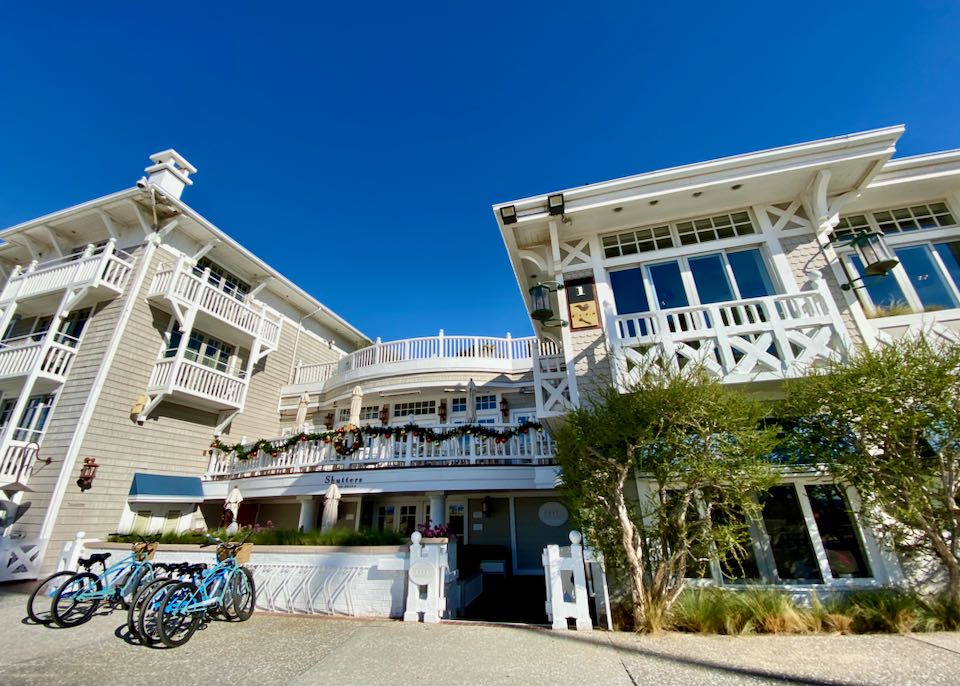
The fantastic Shutters on the Beach in Santa Monica.
7. Malibu
Though it lies some 12 miles (19 km) west along the coast from Santa Monica, Malibu is always associated with LA, with its secluded estates popular with movie stars and celebrities. It’s primarily known for its beaches, especially Zuma Beach, Leo Carrillo State Park, and Malibu Lagoon State Beach (also known as Surfrider Beach). The 1905 Malibu Pier is one of the most iconic landmarks that the city has to offer. Inland, Malibu Creek State Park contains remnants of the set for hit TV show M*A*S*H. There are some good hiking trails and waterfalls if you head into the hills. Two of the most popular are Solstice Canyon and Escondido Canyon Park. While in Malibu, visit the Spanish Revival–style Adamson House and Malibu Lagoon Museum. There are plenty of great restaurants in Malibu, and many offer gorgeous views of the Pacific Ocean. A few to check out are Nobu, Mastro’s Ocean Club, and Duke’s. Malibu Farm Restaurant is a top choice for breakfast and brunch. Malibu is best viewed as an expensive beach holiday destination – there aren’t an abundance of hotels, and even the 2 and 3-star hotels tend to be quite expensive because of the location. Day-trips are relatively straight-forward by car from the rest of LA; Malibu is not a recommended base for exploring the city, though.
- Best Hotels: Malibu Beach Inn • Nobu Ryokan Malibu • Surfrider Hotel
- Best Cheap/Midrange Hotel: The M Malibu
8. Miracle Mile (Central LA)
The district known as Miracle Mile is centered along a section of Wilshire Boulevard between Fairfax and Highland avenues (also known as Mid-Wilshire), in the heart of Los Angeles. The name harks back to its Art Deco heyday in the 1930s, when it experienced a property boom (the El Rey Theatre is a good example). Today it’s best known for the attractions lining “Museum Row”, most notably the Los Angeles County Museum of Art and brand new Academy Museum. Prehistoric history is highlighted at La Brea Tar Pits and Museum, while the Petersen Automotive Museum is housed in striking contemporary premises, a red box wrapped in curving steel ribbons. Finally, there’s the Craft Contemporary, the former Craft and Folk Art Museum. Accommodation options are few here – most folks visit from somewhere else (Hollywood, West Hollywood or Downtown LA are most convenient).
- Best Hotel: Kimpton Hotel Wilshire
- Best Cheap/Midrange Hotel: Beverly Laurel Hotel
9. San Pedro
The scrappy port district of San Pedro is often overlooked by tourists, though it boasts several top-notch attractions. Once wholly working-class, San Pedro has been gentrifying in recent years, with a new waterfront development and public market set to debut in the next few years near the historic San Pedro Fish Market and Restaurant. All the main attractions lie on the water: Los Angeles Maritime Museum, Battleship USS Iowa Museum, and the SS Lane Victory. To the south, Point Fermin Park is southernmost point in LA, featuring Point Fermin Lighthouse and Fort MacArthur Museum, with the Cabrillo Marine Aquarium nearby. The free San Pedro Downtown Trolley links most of the neighborhood’s major attractions (every 25min; Sat & Sun noon–6pm). Accommodation here comprises mostly cheap motels. Connections with the rest of the city are not the best, so it’s not recommended as a base without renting a car.
- Best Hotel: DoubleTree by Hilton Hotel San Pedro
10. Long Beach
The port city of Long Beach, 25 miles south of Downtown LA is well worth a visit with fantastic restaurants, a decent strip of beach, and a smattering of attractions, including the Queen Mary, the Art Deco cruise liner docked here permanently since 1967. Other highlights include the Aquarium of the Pacific, Long Beach Museum of Art, the Museum of Latin American Art, and Pacific Island Ethnic Art Museum in the East Village Arts District. In addition, staying here means easy access to seasonal (November – March) whale watching trips and to idyllic Catalina Island. Two large malls, the central Promenade and harborfront Shoreline Village, attract local and traveling shoppers alike. Long Beach is connected to the Metro system, but the long distances involved keep it from being a top base for exploring the rest of LA.
- Best Hotels: Hyatt Regency Long Beach • Westin Long Beach Renaissance Long Beach
- Best Cheap/Midrange Hotels: Hotel Royal • Best Western Plus Hotel at the Convention Center
11. Pasadena
Historic Pasadena lies some 12 miles north of Downtown LA, best known for its annual Rose Bowl Game and Tournament of Roses Parade, as well as being the location of the California Institute of Technology (Caltech). For visitors, its chief appeal lies in the collection of charming old buildings, restaurants and stores in Old Pasadena, as well as a smattering of intriguing museums and galleries. Highlights include the USC Pacific Asia Museum, the art displayed at the Norton Simon Museum, the Pasadena Museum of History, and Gamble House, an Arts and Crafts-style masterpiece. Three miles southeast of Old Pasadena lies the Huntington Library and its sensational art collection and botanical gardens. Pasadena is connected to the Metro system – it makes a pleasant base for trips further into Southern California and the nearby mountains, but it’s not so convenient for city access beyond Downtown LA.
- Best Hotels: Langham Huntingon Pasadena • Westin Pasadena
- Best Cheap/Midrange Hotel: Hyatt Place Pasadena • Bissell House Bed & Breakfast • Rose & Crown Hotel
12. Burbank & the Valley
Just 12 miles north of Downtown LA, Burbank marks the beginning of the San Fernando Valley, better known simply as “the Valley”. Many movie and TV studios relocated to Burbank in the 1950s through to the 1970s and today it’s best known for the tours of Warner Bros Studios and the theme park experience at Universal Studios in nearby Universal City. The sprawl of suburbs beyond Burbank offers little interest, though Forest Lawn Memorial Park in Glendale contains its own exceptional art museum as well as the resting places of Humphrey Bogart, Michael Jackson, Elizabeth Taylor, and many other movie stars. Further north in Santa Clarita, Six Flags Magic Mountain is a popular theme park with giant rollercoasters. Burbank and much of the Valley is connected to LA’s Metro system, but having a car is far more convenient here.
- Best Hotels: Coast Anabelle Hotel • Lexen Hotel – North Hollywood
- Best Cheap/Midrange Hotel: The Tangerine • El Royale Hotel • Hilton Garden Inn Burbank Downtown
13. Anaheim
Opening in 1955, Disneyland is still one of America’s most popular theme parks and dominates the city of Anaheim, some 25 miles southeast of Downtown LA. Most hotels here are set up to serve Disneyland traffic, though similarly family-friendly Knott’s Berry Farm and Adventure City are relatively close by. There’s not much to Downtown Anaheim, though recent development includes the Anaheim Packing District food court and craft beer makers such as Unsung Brewing Company. Getting between Anaheim and the rest of Greater LA is time-consuming by public transport (a car is slightly better). Staying here is really all about Disneyland.
- Best Hotels: JW Marriott Anaheim Resort • Ayres Hotel Orange • Residence Inn at Anaheim Resort/Convention Center
- Best Cheap/Midrange Hotel: Wyndham Anaheim • Howard Johnson
More L.A. Neighborhoods
With more time these neighborhoods are also worth checking out:
• Koreatown in Central LA is one of the city’s most dynamic Asian neighborhoods, with a smattering of mostly mid-quality hotels. Our favorite is Hotel Normandie.
• Exposition Park and University of Southern California (USC) contain some excellent museums: Natural History Museum of Los Angeles County, California African American Museum, California Science Center, and USC Fisher Museum of Art. We don’t recommend staying around here, though – it’s an easy visit from Downtown LA by car or Metro.
• The streets and shops of Westwood and UCLA are fun to explore on foot, with the Hammer Museum the biggest conventional sight. The best hotel here is Palihotel Westwood Village, but staying in Westwood is less convenient for the rest of the city
• Thanks to the Fresh Prince as much as anything, affluent Bel-Air is one of LA’s most famous neighborhoods, but like most of the wealthy enclaves in the Hollywood Hills/Santa Monica Mountains, there’s actually not much to see here. The swanky Hotel Bel-Air is about the only place to stay. The most famous attraction in the hills is Mulholland Drive, a scenic route best experienced by car.
• One of LA’s premier attractions is the Getty Center, tucked away up in the hills above Brentwood. Luxe Sunset Boulevard Hotel is a good option nearby, but there’s really no need to stay here – The Getty is easy to drive to and several buses connect it with the nearest Metro stations.
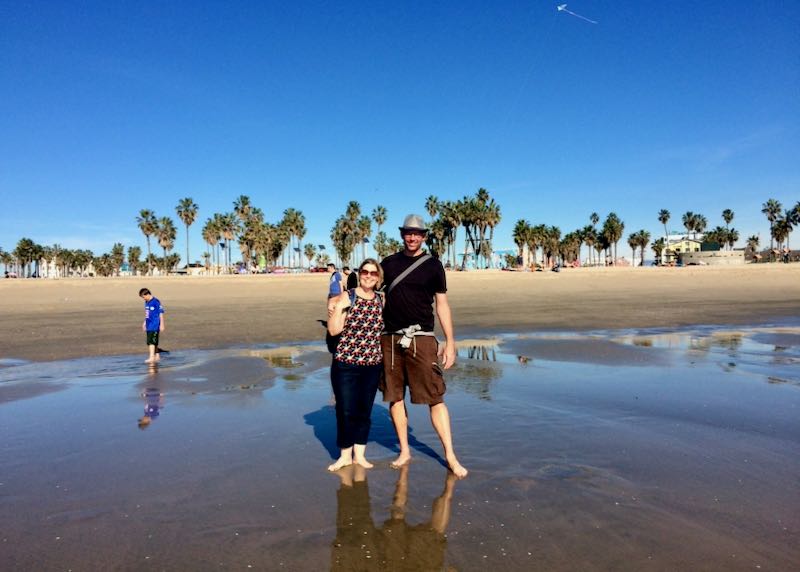
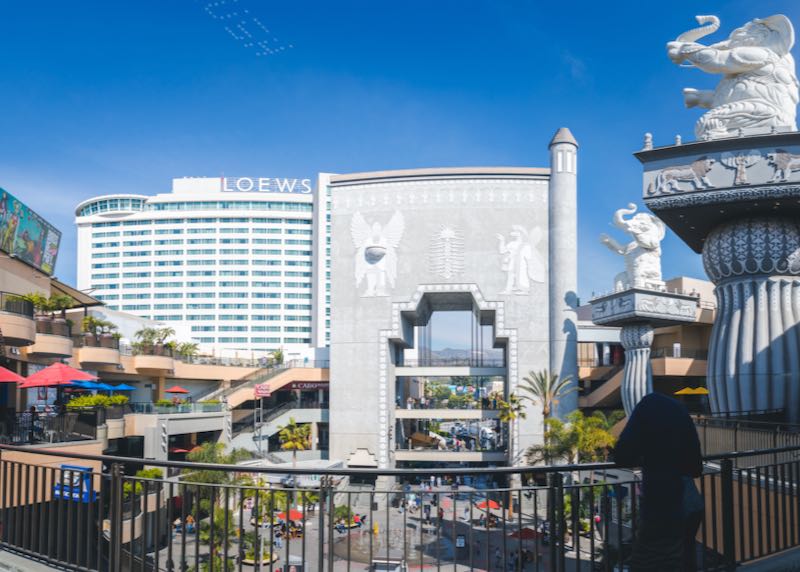
About Santorini Dave